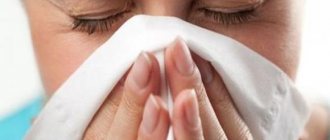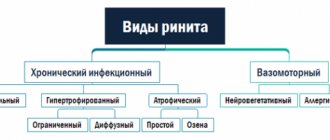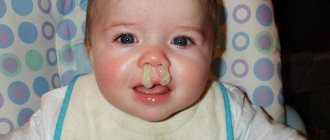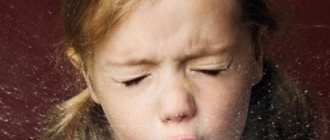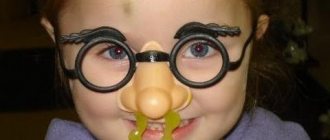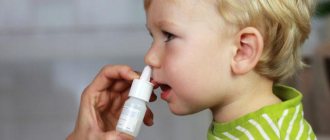Many mothers notice how their infants begin to accumulate snot in the nasopharynx, as a result of which the babies make grunting sounds. Most often, snot in a baby accumulates in the nasopharynx during teething, but there may be other reasons that all parents should be aware of. In the case when a mother hears squelching in her child’s nose, but snot does not flow out of the nose, most likely quite thick mucus is accumulating in the nasopharynx.
This process can be caused by the following factors:
- penetration of infection into the nasopharynx;
- the occurrence of an allergic reaction;
- excessively dry indoor air.
However, it is important to understand that parents cannot independently determine the nature of the origin of such a process; only a pediatrician or pediatric otolaryngologist can do this.
When is there cause for concern?
The formation and discharge of mucus from the nose is a normal phenomenon, representing a protective reaction of the body, but in this case, the snot should be transparent in color and of medium consistency. In this case, the baby’s nasal breathing should be smooth and deep without difficulty. In this case, there is no reason to worry, you just need to wipe the nose, and if necessary, you can suck out the mucus using a rubber bulb.
Humidifying the air in the room, regular wet cleaning and walking in the fresh air will be beneficial; it is better to avoid using medications in such a situation.
If the snot in the nasopharynx of newborns is white, yellow or green, the likelihood of a bacterial origin of the runny nose increases. In case of any painful conditions of the baby, it is important to adhere to dietary nutrition, putting the baby to the breast more often.
Causes of mucus
The formation of mucus in the nose may indicate the development of the disease
In the nasal passage and nasopharynx of newborns, mucus can accumulate for several reasons. In medicine they are divided into two groups: infectious and non-infectious.
Non-infectious. Most of them do not require treatment. Often, all that is required is the exclusion of the irritating factor and the baby’s runny nose goes away on its own. Infectious causes of mucus in the nose of a baby include:
- Allergic reaction. Appears against the background of pollen, animal hair entering the respiratory tract, or after using various hygiene products or eating certain foods.
- Period of teething. Hypersecretion in newborns is the body's response to teething. In certain cases, swelling of the soft tissues of the oral cavity may occur.
- Dry or dirty air. Mucus in the nose in this case is the body’s protective reaction to dust that settles on the mucous membranes of the oral cavity.
- Mechanical damage. A runny nose can appear as a result of a foreign body entering the respiratory tract, which injures the mucous membranes.
- Also, the cause of a runny nose in a baby can be prolonged use of topical medications in large doses. After the drug enters the nasal cavity, swelling increases, which provokes the appearance of a runny nose.
Infectious. The cause of a runny nose is also caused by various viral and infectious diseases. The formation of mucus in the nose can occur as a result of:
- Infection with a viral disease. Associated symptoms are sneezing, nasal congestion, and difficulty breathing. Possible cough, fever and sore throat.
- An inflammatory process that develops against the background of bacterial activity.
Infectious pathologies that are characterized by the appearance of a runny nose include: otitis media, frontal sinusitis, sinusitis, rhinitis, ethmoiditis. The formation of mucus occurs due to intoxication of the body with waste products of pathogenic microorganisms.
Symptoms
It is very simple to distinguish an allergic runny nose from an infectious one!
If the cause of the accumulation of mucus in the child’s nose is various infectious diseases, an increase in temperature, general weakness and malaise are observed.
The clinical picture changes after a few hours, swelling of the mucous membrane occurs. In newborn babies, the nasal passage is quite narrow, which makes breathing difficult. During feeding, the baby has to inhale through the mouth, which leads to swallowing a large volume of air. This provokes abdominal cramps and colic. A runny nose also leads to oxygen starvation of the brain. In this case, neurons stop functioning normally, which provokes headaches.
Signs of a non-infectious runny nose are sweating of the palms, redness of the mucous membranes of the eyes and copious discharge of mucus from the nasal passage. A doctor should be called if the child has difficulty breathing, refuses to eat, and the mucus turns yellow or green.
Help the baby
Often the mucus becomes quite thick and does not come out of the nasal passages on its own, then the necessary measures must be taken. All parents should know that vasoconstrictor drops cannot be used before 6 months of age, and for older children they can also be used only in extreme cases. It is advisable to use salted water to disinfect, cleanse and moisturize the nasopharynx: take a spoonful of sea salt to a glass of water. Infants should not rinse their nose; you can only instill a few drops of sea salt solution or saline into it. To carry out the procedure on such babies, it is much more convenient to use special devices for cleaning the nose, which can be bought in pharmacies - Aqualor, Aquamaris, Humer.
In folk medicine, a remedy known as Kalanchoe juice is known, with which you can thoroughly clean the nose of an infant. When it is instilled into the nasopharynx, a sneezing reflex is developed, during which all mucus is eliminated from the nasal cavity. However, before using the juice, you need to dilute it half with water, and you should also avoid frequent use of this folk remedy.
Mucus in a baby's nose becomes a real problem for parents. Due to the inability to breathe through the nasal passages, the baby becomes capricious and constantly screams, refuses to eat, and often touches his nose. Such symptoms should alert mom and dad, and they, in turn, should take all necessary measures. It is important to understand that the baby’s nostrils and the entire structure in the nasal cavity are narrow, so the accumulated mucus causes acute pain.
Due to age, the child cannot blow his nose and get rid of the discharge on his own. If the respiratory organ is not treated in a timely manner, the child may develop wheezing in the nasopharynx and other consequences. However, timely treatment and identification of the reasons why a baby has snot in the nasopharynx will save parents from many problems.
A newborn baby is often exposed to colds and viral inflammation.
Due to fragile immunity, harmful viruses and infections easily penetrate the nasal cavity and pharynx, causing acute symptoms. Therefore, if a baby has snot squelching in the nasopharynx, it is important to quickly take measures to protect the nasal mucosa.
Mucus should be present in the nasal cavity.
In small quantities, it moisturizes the nasal cavity and protects the surface of the nasopharynx from dust, microbes, and environmental influences.
In addition, the functions of mucus include supporting the functioning of the mucous membrane and preventing irritation of this cavity.
If the main tasks of the mucous secretion are disrupted, the baby develops unpleasant sensations, accompanied by crying and fatigue.
The reason for this process lies in a cold.
If parents have concerns about the flu or a cold, they should contact their pediatrician as soon as possible.
Acute respiratory inflammation
When the body is affected by respiratory inflammation
it is necessary to undergo a course of complex treatment and get rid of the source of the disease.
A runny nose in this case is only one of many symptoms. In addition, the child is worried about chills, fever, increased sweating, and rash.
Overheat
If the child is overly covered or exposed to the sun frequently, the little patient may suffer from heat stress.
With this process, overheating of the body causes congestion in the nasopharynx, which subsequently leads to serious consequences.
Foreign object
If the discharge is accompanied by painful sensations in the nasopharynx, check the nasal cavity for the presence of a foreign object.
If you find an object, do not try to remove it yourself. Thus, you can push the part further down the nasopharynx, causing dysfunction.
The same reason can be attributed to food. If a child is choking, immediate action must be taken.
Teething
Babies often suffer from pain due to the appearance of their first teeth.
With this process, it is natural for a large amount of mucus to be released.
Usually the discharge goes away after three days, but if rhinitis continues for more than a week, it is important to get diagnosed and help the baby regain breathing functions.
Dryness
If the nasopharynx is stuffy for more than a few days, you should pay attention to the humidity in the room
. Excessive dryness can cause a number of processes, including the production of large amounts of mucus.
Allergy
Another cause is an allergic reaction.
on pet hair, dust, particles from flowering and other irritants. Treatment for this process begins with identifying the root cause and eliminating it.
Until this point, medications can only reduce the severity of symptoms. In addition, it is important to establish a rule for daily wet cleaning. Large accumulations of dust are harmful to the baby's health.
Physiological runny nose
If mucus in the nasopharynx torments an infant, the baby is probably going through an adaptation period.
At this time, the newborn’s body gets used to new living conditions. For this reason, drug treatment for rhinitis is not required.
Remember! If your baby has mucus in the nasopharynx that does not go away for a long time, undergo a detailed examination by your pediatrician.
Causes of runny nose in newborns
Children in the first month of life are rare, but may suffer from a runny nose. There may be several reasons:
- viral infection (ARVI);
- bacterial infection (pneumonia of newborns);
- allergic reaction;
- physiological runny nose (excessive mucus production in dry and warm indoor air).
Attention! It is pointless to treat a runny nose, since it is not a diagnosis, but a symptom. Only by eliminating the cause of the runny nose and curing the disease can you get rid of snot. Symptomatic treatment is acceptable when nasal breathing is difficult.
How to treat snot in the nasopharynx in a baby
When wondering how to remove snot from a baby’s nasopharynx, the first thing you need to do is undergo an examination. During the preparation of tests, the doctor may prescribe medical procedures that will help restore breathing and alleviate the child’s condition:
- Carry out wet cleaning daily.
- Get rid of carpets, large stuffed animals and other items that can accumulate dust.
- Monitor your child's sleep. Place a small pillow under your head.
- The child's diet should be reviewed. Install a humidifier in the room. Maintain air humidity at least sixty percent and air temperature about twenty degrees Celsius.
- Don't forget to ventilate the room.
If, following these rules, you do not notice any improvement in your child’s well-being, seek qualified help.
Drug therapy
To remove mucus from the baby’s nasopharynx, you should adhere to complex treatment, which includes the use of the following drugs:
- In case of bacterial infection,
the child is prescribed the antibiotic Amoxiclav. It will relieve the patient of bacteria and harmful pathogens. - To sanitize the nasal cavity,
antiseptic medications are needed - Furacilin, Chlorophyllipt. They will reduce the inflammatory process and reduce the secretion of snot in the nasopharynx. - For instillation
into the nose, the antihistamine Allergodil is required. Zodak, Suprastin, Erius, Zyrtec, Cetrin are prescribed for internal use. They will reduce swelling and improve the child’s well-being. - The course of treatment includes the antiviral drug Grippferon.
The drug is considered safe for treating children, so parents can use the drug without the risk of complications. - To remove phlegm,
the doctor may prescribe inhalations based on essential oils and decoctions of medicinal herbs. - To reduce the production of mucous secretions,
the baby is prescribed vasoconstrictor nasal drops, Vibrocil, Otrivin. They will provide nasal breathing and relieve swelling in the mucous membrane. - To reduce the inflammatory reaction,
the baby needs herbal remedies. It is best to use it, as it is the safest for treating children. - Don't forget about the need for hygiene.
In addition to daily bathing procedures, it is important to rinse your baby's nasal passages. To do this, use Otrivin baby. If the child is not an infant, doctors prescribe saline solutions - Humer and others. In the absence of allergic reactions, the solutions can be replaced with decoctions of chamomile or sage. - Do not remove crusts from your nose.
To moisturize and easily eliminate secretions, use oil solutions.
If the discharge appears due to a cold, the child may be prescribed heat treatment.
. However, such procedures are prohibited at high temperatures. Use salt or cereal lotions as a means of warming. By warming up the nasal passages, you will improve your baby's breathing functions and overall well-being.
Important! The baby should be given plenty of water throughout the treatment.
How to clear snot from a baby's nasopharynx
The runny nose will disappear in a matter of days. Try this remedy...
Read more…
Parents often notice snot in the nasopharynx of their infant. In these situations, the child makes sounds that are similar to grunting. Fluid may accumulate due to the gradual appearance of teeth. There are other factors that adults need to be aware of to prevent complications.
A baby's snot interferes with eating and breathing. The accumulation of mucus often leads to vomiting. The child may also develop a specific odor from the mouth. Your child may notice difficulty swallowing.
List of reasons
A child is born without the final formation of some organs. It takes time for the systems to start working continuously and smoothly. The nasal mucosa in infants undergoes a peculiar adjustment for another 2-3 months, producing a mucous secretion. There is no swelling. Doctors call this phenomenon a physiological runny nose.
Nasal breathing is slightly difficult. Physiological rhinitis is not treated with traditional medicine and folk recipes. You just need to carefully remove excess liquid using cotton pads.
Infectious rhinitis is characterized by the following changes:
- Lethargy and capriciousness of the child,
- First, clear fluid from the nose, and then pus and mucus.
In this situation, consultation with a doctor is necessary. A specialist will examine the child and prescribe nasal cleansing products. Unskilled actions can provoke inflammation of the middle ear or bronchitis.
Ways to deal with nasal discharge
Use salt-based products to remove snot
If a baby has snot in the nasopharynx, you need to know exactly what to do. Sometimes the discharge becomes thick and can no longer be cleared through the nose.
Drops that constrict blood vessels cannot be used for children under six months of age. For older children, this method is allowed only in certain situations.
When answering parents' questions about how to get rid of a runny nose, doctors advise using weak saline solutions. You need to dilute half a dessert spoon of sea salt in 250 ml of water. Very young children are not washed with this solution, but put drops in their nose.
To remove snot, it is recommended to use salt-containing products, such as Aquamaris or Humer. You should first study the age at which medications can be taken.
Kalanchoe is recognized as an effective traditional medicine for getting rid of the runny nose. The juice of this plant quickly cleanses the baby's nasal cavity. When instilled, a sneezing reflex is evoked and the liquid is removed from the nasopharynx. It is not recommended to use juice in its pure form; it must be diluted with water.
Parents of an infant need to know that timely treatment of viral rhinitis, which is the result of ARVI, can remove mucus in the nasopharynx in about a week. Methods must be tailored to the characteristics of the disease. It is important to identify the causes of discharge, and only an experienced doctor can do this.
The baby’s body can overcome the disease on its own; it is important to create conditions for the fastest possible recovery. In particular, it is required to ensure:
- Frequent drinking
- Wet cleaning and ventilation of the children's room,
- Taking antipyretics if necessary.
Washings, inhalations and medications
A solution of chlorophyllipt with saline can be used for inhalation
When studying how to remove snot from newborns, it is worth remembering that when this unpleasant situation occurs, rhinitis cannot be eliminated within 1-2 days. To remove snot from the nasopharynx, you need to eliminate the causative agent of the disease.
Your doctor may prescribe antiviral nasal drops for the first 3 days, especially if the fluid is too thick and difficult to come out of your nose. First you need to clean the nasal passages with a solution of salt.
If the rhinitis that appears is not of bacterial origin, then it is quite enough to use simple procedures for rinsing the nasal cavity. It is safe and effective to use pharmaceutical solutions. For example, Aqua Lor is indicated for treatment from the first days of a child’s life.
It is permissible to prepare such products for a child at home. You can choose either regular or sea salt. The procedure is carried out three times a day. Each nasal passage is washed in turn.
Another effective way to treat a runny nose is inhalation. The best device is a nebulizer, which allows you to treat rhinitis even in a newborn. In addition, doctors advise in case of a viral runny nose to take inhalations with interferon. You need to take 1 ampoule of the product and dilute it in 2-3 ml of clean (preferably mineral) water. The procedure is performed at least three times a day.
For bacterial rhinitis, it is useful to inhale with chlorophyllipt. Take a 0.1% solution of chlorophyllipt and mix it with saline in a ratio of 1:10. This treatment is carried out 3-4 times a day.
Allergic reactions
Manifestations of allergies in a child may include:
- fluff,
- wool,
- dust,
- pollen.
When an infant has a very itchy nose, watery eyes, sneezes and cries due to a large amount of nasal discharge, it is important to try to identify the allergens present. For example, a child can sleep under a duvet, or in the garden near the house, certain plants have bloomed.
It is important to immediately neutralize existing irritants. Allergic rhinitis is subject to mandatory treatment based on consultation with a doctor.
This condition can develop into bronchial asthma, which is dangerous due to suffocation. Particular attention is also paid to a runny nose if the child’s relatives suffer from constant severe allergies.
You should go to the doctor and clearly find out what exactly the child is allergic to.
Mechanical causes of a runny nose
Children, even at one month of age, can be very fast and inquisitive. In some cases, even a very attentive mother does not notice how the child inserts small parts of toys, food or other objects into his mouth or nose. When an object gets into the nose, it causes extreme irritation and swelling of the mucous membrane, and a severe runny nose appears.
Some young children have a deviated nasal septum. As a result, chronic rhinitis may occur. If fluid comes out of your nose for a long time, it is important to visit your pediatrician. While examining the child, the doctor determines the correct location of the septum. When it is bent, the nasal passage narrows, which impairs breathing and leads to irritation of the mucous membrane.
Nasal discharge that does not go away for a long time is a process characteristic of recovery from an illness when the child was treated with medications for a long time. Medicines can cause a situation where the vessels of the nose can no longer function normally because they have become “unaccustomed” to it. It is necessary to strictly monitor the duration of taking any medications.
Why do they appear?
Colds are the most famous and common cause of snot. If an infection or virus enters the body, the secretion of mucus becomes a protective reaction of the body. The mucous membrane of the nasopharynx is damaged, and it begins to defend itself in this way. At the same time, other well-known signs of a cold appear. In this case, the child must be shown to a doctor so that he can make a diagnosis and give recommendations for treatment.
But it turns out that, besides the common cold, there are other reasons why snot appears. This may be due to too high humidity in the house, or vice versa - when the air is too dry. The mucous membrane will also react by secreting mucus, liquid and transparent. Another option is nasal congestion, which can result from stagnation of mucus inside.
Snot can be an individual reaction of blood vessels. Children who are fed formula rather than breast milk are sometimes exposed to this risk.
Excessive mucus secretion occurs due to a deviated septum, when one nasal passage becomes narrower than the other. Then the mucous membrane of the nasopharynx will swell. The cause of such a disorder can be either trauma or a congenital feature. Therefore, snot can appear even in a newborn baby.
Nowadays, even children often have allergies. In addition to clear liquid discharge from the nose, it can be identified by sneezing, swelling of the eyes, watery eyes and constant itching in the nose and throat.
A mother who is too keen on using medications can cause her child to have a constant runny nose. Most vasoconstrictor drops dry out the mucous membrane and cause addiction, as a result of which they further increase the formation of mucus.
A common cause of a runny nose in a baby is a sharp change in air temperature. At the same time, mucus begins to actively secrete, and the child begins to snot. But this is by no means an alarming signal. It’s just that the mucous membrane of the nasopharynx reacts in this way to changes in the external environment.
Hypothermia, even minor ones, is dangerous for a baby. But overheating can cause even more harm, as sweating increases and the body becomes dehydrated. Because of this, protective functions are reduced.
Why does an infant have a grunting nose without a runny nose?
An incomprehensible nose grunt that occurs in a baby for no apparent reason can be constant or periodic. This is a rather alarming symptom, which nevertheless does not always indicate trouble. Children may sniffle due to:
- Development of various diseases of the throat and nose (ARI and ARVI). Such diseases can occur even in infants, but sometimes they do not manifest themselves in full force or immediately.
- Lack of proper care (particularly due to dry environment).
- Certain congenital anomalies.
- Trauma and foreign bodies. Such troubles can happen even in children as young as 2 months old under certain circumstances.
If a child grunts through his nose, but there is no snot, it is better to play it safe and consult a pediatrician. Even with a routine examination, an experienced doctor can look at any problems, if any.
Infection in a newborn
Perhaps the most common cause of snorting in young children is a cold. Even newborn babies can get sick from ARVI, for example, if they become infected from their parents or other loved ones. Most often, the disease leads to an increase in temperature and a deterioration in the child’s general condition. But sometimes the illness is not too pronounced - the baby may become only a little lethargic and grunt its nose a little. Also, such a symptom occurs after the illness has been successfully transferred, when the baby is recovering. In such a situation, grunting is just a residual runny nose.
If you suspect a cold is developing, you should measure your baby’s temperature and call a pediatrician at home.
Dry air in the nursery
The nasal mucosa in young children is particularly sensitive. If the baby is in a not very favorable environment - a dusty room with dry air, crusts will form in his nose. And the mucous membrane itself will become swollen. As a result, nasal breathing will become difficult and audible: the baby will sniffle and grunt.
The optimal humidity level in a nursery is at least 50%. If the baby is constantly dry, the risk of developing colds and other health problems increases.
Narrow nasal passages and congenital anomalies
Of course, a child’s nose is significantly different from an adult’s. Doctors assure that all children under three months of age have narrow nasal passages as a natural anatomical feature, so a runny nose in such babies is much more difficult than in adults. Severe narrowing of the nasal passages, even with a minor cold or the formation of crusts in the nose, is fraught with the development of hypoxia - not enough oxygen and nutrients reach the child’s brain, which can lead to serious developmental disorders.
If a child constantly sniffles through his nose, and sometimes even cannot breathe fully through it, this may indicate congenital anomalies that require surgical correction. Such children are recommended to be examined by a qualified ENT specialist who can diagnose the problem and select the optimal methods for its correction.
Injuries and foreign bodies
Of course, in newborn babies, injuries to the nose, as well as foreign bodies in it, are extremely rare. Such a nuisance can happen due to careless care of the baby or as a result of an accident.
Slightly older children can accidentally scratch their nose, and the trauma suffered can cause prolonged grunting. At the site of the scratch, a fairly large bloody crust often forms, under which the mucous membranes heal. This is what causes the nose to sniff.
More serious injuries, such as a fall, can also lead to nasal breathing problems. In this case, you cannot do without additional consultation with a traumatologist, X-ray examination or ultrasound. Such procedures will not harm even a newborn, but will help identify the problem.
If there is a suspicion that some foreign body may have gotten into the child’s nose, under no circumstances should you try to remove it yourself. This is fraught with even deeper pushing.
If your baby is sniffling for unknown reasons, it is better to consult a doctor, even if the sniffing is not accompanied by any other health problems.
How to solve a problem
To rid your baby of snot, there are simple effective ways:
- washing;
- inhalation;
- nasal drops;
- Cleaning the nose with a cotton swab.
Washing alone is often sufficient. The main thing is not to be lazy and do them regularly, at least 5-6 times a day. The simplest solution is salted water (1 teaspoon of salt is diluted in a glass of boiled water). You need to instill such a solution into the child’s nose, and after a while it will simply flow out along with the mucus. If possible, it is better to get sea water enriched with iodine, or use sea salt for the solution. Essentuki-17 mineral water is also good, but before instillation you need to release the gases from it. Salt water successfully removes mucus, moisturizes the mucous membrane and rinses the nose, clearing it of germs.
Inhalations are effective if the snot was caused by a viral infection. They need to be done using an inhaler using saline solution. The optimal number of procedures is 3 times a day. Even a baby can be treated this way, and if the baby likes it, then 1-2 procedures can be added. However, to use inhalations, it is necessary to consult a doctor who will make an accurate diagnosis, since in the case of a bacterial infection, inhalations are contraindicated.
Even doctors rarely recommend medications and only as a last resort. A specialist makes this appointment for a severe cold, when the child’s nose is stuffy and is not breathing at all. Then it is recommended to instill antiviral drops, and in the most extreme case, drops with antibiotics.
If the snot is thick and does not flow out of the nose, it can be removed manually. To do this, a small piece of cotton wool is twisted into a flagellum, lubricated with oil and rolled in a small nose. This procedure is painless and does not harm the baby.
If a child has a hereditary predisposition to allergies or an allergic reaction to some external irritants is suspected, you should bring this to the attention of a doctor. If the snot is caused by an allergen, you will need to consult an allergist and you will need to treat it with completely different means than for a cold.
What to do?
If the child begins to grunt his nose, you need to carefully examine him and analyze his general condition. Further actions may be as follows:
- If you suspect a cold, you should consult your pediatrician.
- To moisturize the nose and eliminate dry crusts, you should use regular baby nasal drops (based on sea water) or saline solution. They need to be instilled in 2-3 drops. in each nasal passage several times a day. Soaked crusts can be removed with a soft cotton wool pad.
- In order for the baby to breathe freely through his nose, it is extremely important to create an optimal microclimate in the room. In particular, during the heating season it is necessary to monitor air humidity (to monitor these indicators, you can purchase a special device - a hygrometer). To prevent it from falling below the recommended norm, you can simply hang wet towels over the radiators or place containers of water around the apartment. But a much smarter and more controlled way to humidify the air is to use a humidifier.
- To prevent dust from getting into a child's nose, it is important to carry out daily wet cleaning of the room, as well as regularly ventilate the home and shake out bedding. Of course, it is better to empty the house of various dust collectors (carpets, large soft toys, etc.).
If, despite all efforts, the child’s nose grunting does not go away, but there is no snot and general health remains normal, do not let the situation go. A medical consultation will definitely not be superfluous.
When do you need to urgently call a doctor?
The health of newborns and infants requires special attention. You should definitely call a doctor at home if the nose grunting is accompanied by:
- Cough.
- Skin rash.
- An increase in temperature indicators.
- Digestive disorders.
- Visible deterioration in health, drowsiness and lethargy.
The doctor will be able to carefully examine the baby and draw conclusions about possible health problems or whether there is a need for additional examination (by specialists) or tests.
Folk remedies
In addition to saline solutions, other products based on natural ingredients can be used to treat a runny nose in a child.
To relieve swelling of the nasal mucosa and nasopharynx, it is recommended to prepare a herbal decoction. There are several options:
- yarrow;
- calendula;
- chamomile;
- sage.
The decoction is prepared in a water bath. You can take one ingredient or make a mixture. You need to instill the decoction into your nose 2-3 times a day, and before doing this, be sure to rinse your nose with saline solution.
If the snot is thick and does not flow out, you need to give the baby plenty of warm drinks. Then the mucus will become more liquid and it will be easier to get rid of it.
It is important to take preventive measures and maintain moderate air humidity in the house. If the room is too damp, remove the source of dampness. If the air is too dry, use humidifiers and do wet cleaning every day. You need to regularly ventilate the room so that the air is fresh and foreign odors do not accumulate.
Snot in a newborn is the first sign that a cold is developing in his body. However, there are a lot of simpler problems that can also make it so that in . The catch is that only a doctor can correctly diagnose and understand the cause; self-medication is unlikely to bring any effective results. For example, many children are characterized by infectious rhinitis, which they develop as a reaction to contact with already ill adults - harmful bacteria seep into the body and begin to multiply there.
What measures to take?
Having seen that the baby has snot, it is necessary to take the necessary measures in a timely manner:
- remove accumulated mucus using special devices;
- prevent the mucous membrane from drying out by moisturizing it with solutions of sea salt;
- drip the nose with vasoconstrictors to relieve swelling of the mucous membrane;
- Maintain the necessary air humidity in the room.
Mom cleans baby's nasal cavity with a nozzle suction
The immediate reaction of parents to the appearance of a runny nose in a child will save their baby from many health problems, because snot in infants is much more difficult to cure than in adults.
If you have questions for your doctor, please ask them on the consultation page. To do this, click on the button:
Ask a Question
Related Posts
- How to blow your baby's nose
- Vasomotor type rhinitis in children
- Acute rhinitis in children: signs and treatment
- Flying on a plane with a child who has a runny nose
general information
It often happens that parents do not understand the situation - the child is breastfeeding, but the baby has snot or even a hoarse cough. At the same time, parents’ independent searches often stop at the fact that mother’s milk does not help create immunity in the child.
They are fundamentally mistaken. Mother's milk in 99% of cases provokes the active building of immunity, this is a good remedy.
Moreover, in reality, the indicator of the presence of protective functions is not the complete absence of diseases, but the baby’s ability to fight them. If a baby lives in the middle of a metropolis, then he inevitably encounters a huge number of bacteria and harmful microorganisms of various kinds. It is even worse if there is a second older child who attends school or kindergarten - from there he is guaranteed to bring a lot of infections, but he himself will not get sick, but he will infect the younger one. So in such a situation, sooner or later the nose is guaranteed to start snotty and there is nothing terrible or unnatural about it. Therefore, if a runny nose goes away calmly - without fever or other symptoms, then there is nothing to worry about, this is a good way for the immune system to show itself in action.
However, there are other types of runny nose that may appear:
- The physical type of runny nose is typical for people due to the fact that the vessels in their nose have not yet had time to form normally. This kind of nasal runny nose is quite rare and requires a trip to the doctor;
- An infectious runny nose is caused by an infection or harmful bacteria;
- Allergy. The child may not tolerate dust or food that may contain some kind of carcinogen. In such a situation, tears may appear from the eyes as a sign of an allergy.
Of course, among the types of runny nose presented, the most common is an infectious runny nose, but in any case, it is advisable to immediately see a doctor and he will tell you what is wrong with your child.
How to suck out snot from a newborn
A child behaves capriciously for a number of reasons. Quite often, adults cannot immediately determine the nature of his indignation. For example, in infancy it is impossible to independently get rid of snot that has accumulated in the nose. In this case, parents should come to the rescue. They should know how to suck the snot out of a baby.
The symptom often appears in an infant with various diseases of the upper respiratory tract. Inconvenience and discomfort affect the overall well-being of the child. A baby in this condition feels bad for a number of reasons:
- Unable to breastfeed well. If your nose is clogged, it becomes difficult to eat and breathe at the same time. That is why in this situation many children experience a deterioration in appetite. Some of them even refuse food.
- An infant with a stuffy nose needs to breathe through his mouth. However, immediately after birth, babies do not have such skills. A runny nose can cause the baby to choke.
- The child's body has a number of characteristics, so rhinitis develops against the background of the negative influence of external and internal factors. If the inflammation is not eliminated in time, it can spread to the throat or ears. Acute otitis media in infancy is dangerous and can lead to the development of deafness. Parents should not ignore the symptom and do everything to eliminate it.
It is necessary to suck out a baby's snot, because only through this procedure can you get rid of a large amount of accumulated mucus. Before starting the procedure, you need to know exactly how to perform it and consult with your doctor.
It is most convenient to use a snot aspirator for newborns.
Methods for removing mucus
Today, there are many ways to help a newborn get rid of snot. Manufacturers offer additional devices that will make the procedure better and faster. As a result, the baby is guaranteed to have a clean nose and be able to breathe deeply.
Removing snot using a syringe
When suctioning using this device, you must perform all actions according to this diagram:
- You can only use a syringe without a needle. Additionally, air must be removed from it.
- The procedure should begin at a time when the child is completely calm.
- Before inserting the end into the nostril, it must be smeared with Vaseline. Otherwise, the risk of damage to the mucous membrane increases.
- The piston must be pulled smoothly, without sudden movements.
- The procedure is performed for each nostril separately.
- After completing the manipulations, the nose should be wiped with a clean cotton swab.
To suck out snot, you need to thoroughly wash the syringe again using warm water or saline solution.
Using a syringe to remove snot
A rubber bulb with a plastic spout will help quickly and effectively remove mucus from your baby's nasal cavity. It is often used due to its reasonable cost and ability to control pressure. To complete the procedure, you must complete the following steps:
- The pear can only be used after heating. In this case, the most comfortable conditions will be created for the children.
- Apply a small amount of Vaseline to the end.
- The baby should be as calm as possible.
- It is best to remove snot 30 minutes after eating.
- You must try to remove as much air as possible from the syringe. After this, the tip is inserted into one of the nostrils.
- Suction should be done smoothly. Otherwise, the risk of discomfort increases.
- The manipulations are repeated exactly for the second nostril.
- After completing the procedure, the nose must be wiped with a cotton swab and saline solution.
The pear should be thoroughly washed in boiled water with a disinfectant.
Using a syringe to remove snot is the most affordable way
Mechanical devices
It is most convenient to use an aspirator to remove snot from the nose. This device consists of two tubes with a small reservoir between them.
With its help, snot is sucked out according to this scheme:
- The device must be washed before each procedure.
- The tubes are connected according to the diagram and connected to the tank.
- Mommy must do everything to ensure that the baby becomes as calm as possible.
- Apply a small amount of Vaseline or peach oil to the tip of the tube.
- The device must not be inserted deeply. Do not damage the mucous membrane.
- The parent takes the second end of the tube into his mouth and smoothly draws in air. It is not allowed to do this abruptly.
- It is necessary to carry out the procedure separately for each nostril.
- After you finish removing the snot, you should wipe your nose well.
The suction must be cleaned of mucus after each procedure. Thanks to this, it will be possible to prevent further development of the infection.
Electrical devices
When sucking, it is most convenient to use a fully automatic device. However, you must first adjust the power correctly. As a rule, such models contain melodies in their memory that help the child calm down. Thanks to the aspirator, it is possible to eliminate snot with mucus even if it is too thick.
We recommend reading: How to remove snot from a newborn
You can suck out snot correctly if you adhere to the following scheme:
- Apply a small amount of oil or Vaseline to the tip.
- Gently insert one end into the nasal cavity.
- Click on the special button.
- Remove the tube from the passage and repeat the manipulation with the second nostril.
- Remove any remaining snot or mucus using a cotton pad.
- After completing the procedure, the reservoir should be thoroughly rinsed and accumulated mucus removed. You must use soap during the process.
If mommy notices snot with blood, then it is not recommended to continue the procedure. In this case, you should not hesitate to contact your pediatrician for advice.
Snot in infants should be eliminated in a timely manner
Using special cotton wool flagella
After the suction procedure is completed, crusts may remain in the nasal cavity and dry to the nasal mucosa. It is not advisable to use an aspirator to remove them. In this case, turundas can save the situation.
These devices must be used according to the following scheme:
- It is most convenient to make flagella from cotton pads. They should match the shape of the baby's nostrils.
- Before starting the procedure, they must be soaked in peach or sea buckthorn oil. Some women prefer to do this in saline or even breast milk.
- Flagella can only be inserted into the nostril carefully. The mucus will become soaked in a few minutes; only after this is it possible to remove the crusts.
- Cotton swabs can be used once.
- After completing the procedure, the nose is thoroughly wiped with a cotton swab, which was previously soaked in saline solution.
How many times can flagella be used? Parents should know that this procedure can only be carried out with disposable instruments.
Preventive actions
Parents should focus all their efforts on preventing the development of snot in their baby. To do this, it is enough to dress him warmly and adhere to the basic rules of personal hygiene. Humidifiers help improve the condition of the mucous membrane. If you follow these simple rules, you won’t have to get rid of snot using suction in the future.
mladeni.ru
Accumulation of mucus in the nasopharynx
Things are a little different; if the nasopharynx accumulates mucus, this is not an ordinary runny nose. Sometimes parents themselves notice, for example, if the air temperature in the child’s room has changed sharply. And this is a normal reaction of the nose to the changes that have occurred, there is nothing wrong with it.
Overheating can bring great danger to a child; a slight hypothermia will not cause as much harm. A newborn’s nose appears during overheating in an attempt by the body to moisturize the internal nasal cavity, as the body is rapidly losing moisture. But severe hypothermia provokes mucus in the baby’s nose because it promotes the development of pathogenic bacteria.
In addition, there is a well-known fact - young children have narrow nasal passages, so mucus often accumulates there because it cannot come out normally. Therefore, at this age you cannot do without a special cleaner, which must be used every day until adulthood. You need to remove snot from your baby quickly, otherwise it may start flowing in the opposite direction.
If the reason lies in the child’s allergies and the snot coming out of the nose is clear, then you will have to start looking for the irritant, because until it disappears, the snot will also not go away. With allergies, burning of the eyeballs, itching and tears are also often noticed, so the baby’s condition must be carefully monitored. Antihistamines can also help cope with this problem, but they can only be taken with the permission of a doctor.
How to recognize symptoms in infants
To correctly determine the cause of snot in a newborn, you need to pay attention to other symptoms, if any:
- cough;
- increased body temperature;
- redness of the mucous membrane of the eyelids.
In addition to the symptoms, you need to think about what happened to the child over the last day or two. Perhaps someone came to visit the newborn with a cough, or the mother washed the clothes with a new fragrant powder and hung them in the room to dry. Having added up all the circumstances, paying attention to the violation of the child’s condition, it will be possible to independently draw a conclusion or help the doctor make a diagnosis.
A newborn may develop sniffles if the environment is not suitable for comfortable nasal breathing, that is, the air is dry and heated to more than 22˚C. This is due to human physiology. In order for the lungs to send oxygen from the inhaled air into the blood, and remove carbon dioxide from the exhaled air, the incoming portion of air must be warmed up to body temperature and have 100% humidity. The air inhaled through the nose, the mucous membranes are prepared for gas exchange: they moisturize and warm it.
Therefore, if an infant is in a stuffy room, the mucous membranes of his nose are forced to increase the production of secretions in order to bring the parameters of the inhaled air to the levels required for gas exchange.
Impaired nasal breathing
By the color of the mucus secreted by the nose, you can determine the type of infection that caused the disease. The secretion secreted by the mucous membranes contains special cells that fight the pathogen. The composition of the snot depends on which microbe caused the disease.
During bacterial infections, the mucus secreted by the nose contains large quantities of cells, which turn yellow or greenish during the fight against pathogenic bacteria. Therefore, this color of snot in a baby can be considered one of the signs of a bacterial infection, which means it is a signal indicating the need to seek help from a pediatrician, who may prescribe an antibiotic.
In the mucus secreted by the nose, red strings can be found - blood streaks, when vasoconstrictor drugs that are not suitable in dosage or form of release are dripped from the snot of a newborn.
Attention! For children under one year of age, vasoconstrictor drugs can only be given in the form of drops. The spray, spraying the substance into the nose, creates dangerous pressure that can lead to otitis media or damage the capillaries.
The acceptable form of vasoconstrictor drugs is only in drops
It is permissible for infants to drip vasoconstrictors based on phenylephrine into the nose. These drugs do not damage the baby’s blood vessels and do not dry out the mucous membranes, which means that the resulting snot from their use will not have streaks of blood in its composition.
During teething, especially the upper canines, as well as the first and second teeth of the lower and upper jaws, a runny nose often appears. This occurs because the irritated and inflamed mucous membranes of the mouth are located close to the nasal passages, which causes the nose to respond with protective mucus to the inflammatory process. This type of runny nose will go away on its own, immediately after the tooth erupts.
If your baby's snot is colorless and transparent, it is caused by either a viral infection or an allergy. Thickening of the mucus produced indicates that the child is not drinking enough fluids, and the air he inhales is dry and overheated. This means that thicker and more transparent snot is a good reason to give the baby more and more water, and also to normalize the air parameters (ventilate the room).
Features of a child's nose
Doctors conducted studies of small children and came to the conclusion that babies sometimes sniffle in their noses without any good reason.
If a child has not yet turned at least six months old, but proceeds without any other symptoms, it does not mean at all that he is affected by the disease. This extraordinary phenomenon was called physiological snot and they came to the conclusion that in this case it is not necessary, you just need to carefully clear the baby’s sinuses. This is the difference between adults and very small children - if an adult has a runny nose, then this is inflammation in the body. In a newborn, snot in the nasopharynx can mean something completely different.
Ways to help your child
It is necessary to remove sputum from an infant in a timely manner; if this is not done, then it will gradually move into the oral cavity and pharynx. If the mucus gets into the respiratory tract, a serious illness may begin. The constant presence of mucus in the throat and nose significantly worsens the general condition of the baby, he becomes lethargic, loses his appetite, and he is not happy to see his parents.
If there is squelching in the nasopharynx, then you can help with the following methods:
- Buy a humidifier or use improvised means to increase the humidity in the room;
- Give your child water more often;
- Try to rinse your nose and throat more often;
- During illness, exclude fried and too salty foods from the young body’s diet.
If a child sniffles, then the most effective way to help him is to regularly rinse the nasopharynx. It is important to use furatsilin or potassium permanganate as a solution. If you want to use only natural ingredients, then a decoction of chamomile, sage, and calendula is also suitable. To prevent the development of this disease, it is necessary to monitor the child’s condition and carry out preventive procedures every day.
